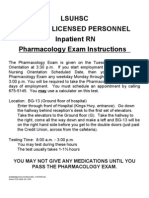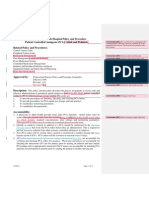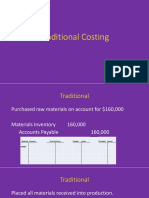Enoxaparin MAG
Enoxaparin MAG
Uploaded by
mlbrown8Copyright:
Available Formats
Enoxaparin MAG
Enoxaparin MAG
Uploaded by
mlbrown8Original Description:
Original Title
Copyright
Available Formats
Share this document
Did you find this document useful?
Is this content inappropriate?
Copyright:
Available Formats
Enoxaparin MAG
Enoxaparin MAG
Uploaded by
mlbrown8Copyright:
Available Formats
Medication Administration Guidelines (MAGs) Via Christi Hospitals Wichita, Inc.
Generic Name Brand Name Patient Population Route of Administration SQ Enoxaparin Lovenox Adult Area for Drug Use (see below) 4 Standard Concentration and Solution Prefilled syringes: 30 mg in 0.3 ml syringe 40 mg in 0.4 ml syringe 60 mg in 0.6 ml syringe 80 mg in 0.8 ml syringe 100 mg in 1 ml syringe 120 mg in 0.8 ml syringe 150 mg in 1 ml syringe Dosing and/or Rate of Administration Administration is by subcutaneous injection in the abdomen at least 2 inches away from the naval. It is important to rotate injection sites with each administration. Prophylaxis: 30 mg SQ BID or 40 mg SQ daily Treatment: 1 mg/kg SQ BID or 1.5 mg/kg SQ daily (DVT/PE only) STEMI: May give 30 mg IV bolus with first dose of SQ for more rapid onset of action PCI: If therapeutic SQ enoxaparin given 8-12 prior to PCI then IV bolus dose of 0.3 mg/kg may be given Administration Considerations IV Line Requirements Special Flushing and Tubing Requirements Personnel Administration Requirements Extravasation Risk Onset of Action and Duration Dose Adjustment Recommendations N/A N/A N/A
IV Push
N/A Clinical Considerations Onset: 3-5 hours Duration: 12 hours For CrCl < 30 ml/min prophylaxis dosing is reduced to 30 mg SQ daily and treatment is reduced to 1 mg/kg SQ daily. Enoxaparin dose may be adjusted per anti-Xa level according to the Via Christi enoxaparin nomogram (PH-MED-62 Exhibit A) A baseline hemogram and Scr (or within the last 24 hours) should be obtained at enoxaparin initiation. Ongoing laboratory parametersinclude a hemogram and Scr twice weekly.
Monitoring Requirements
Laboratory Considerations Reversal Recommendations
Anti-Xa levels may be drawn in select patient populations where efficacy or toxicity is a concern. Consider an anti-Xa level in pregnant patients, patients with severe renal insufficiency, pediatrics or obese patients. Therapeutic anti-Xa levels are 0.5-1.0 for treatment doses of 1 mg/kg SQ BID or 1-1.5 for treatment doses of 1.5 mg/kg/daily. Therapeutic prophylactic anti-Xa levels are 0.2-0.5 for both 30 mg BID and 40 mg daily dosing. N/A Protamine sulfate and packed red blood cells can be given in the event of an enoxaparin overdose or major bleed. Protamine reversal is not complete (approximately 60%). If it is less than eight (8) hours since an enoxaparin dose, 1 mg of protamine should be given for every 1 mg of enoxaparin. If it has been 8 to 12 hours, then 0.5 mg of protamine per 1 mg of enoxaparin should be given. If it has been greater than 12 hours since the enoxaparin dose, protamine is not effective and should NOT be given. Only Via Christi approved protocols may be utilized for treatment with therapeutic enoxaparin. Do NOT expel air bubble at tip of syringe. Insertion or removal of an epidural catheter is not recommended while a patient is receiving enoxaparin. Avoid IM injection administration.
Other
Area for Drug Use: 1 = Intensive Care Units, Emergency Rooms, Code Blue, Cardiac Cath Labs, VC-SF: SPS. 2 = Cardiac Units, VCH-SF: 4SW, 4SE, 6CAD, 8SW VCH-H: 5W, 6E VCH-ST: 3E, 3N 3 = Operating Room Areas (Includes OR, Recovery, Pre-Anesthesia Care Unit), VCH-H: MOPS 4 = Hospital wide, cardiac monitor NOT required 5 = Hospital wide, cardiac monitor required 6 = Sedation. Use must be in accordance with the Via Christi Regional Medical Center Sedation Policy 7 = Rapid Response Team presence required All drugs should be administered by an infusion pump unless otherwise specified or ordered. Please see Clinical Pharmacology for full drug information. Abbreviations: MSTU: Medical/Surgical Transplant Unit (VCH-SF) ODCU: One Day Care Unit (VCH-SF) PALS: Pediatric Advanced Life Support Updated Name Stephanie Schroeder Tari Malmgren Taylor Gill Taylor Gill Taylor Gill
Date 12/17/2002 11/11/2005 10/14/2010 04/14/2011 04/11/2013
You might also like
- Question 3 Direct Contact With A Live, Mains Voltage Electricity Supply System Within A Workplace CanDocument6 pagesQuestion 3 Direct Contact With A Live, Mains Voltage Electricity Supply System Within A Workplace CanrahularenNo ratings yet
- Nclex 3 With RationaleDocument13 pagesNclex 3 With RationaleMsPocketbook HoarderNo ratings yet
- Unfractionate Heparin Low Molecular Weight HeparinDocument3 pagesUnfractionate Heparin Low Molecular Weight HeparinArun KumarNo ratings yet
- Pro TaminaDocument2 pagesPro TaminaArcenciel26No ratings yet
- Fraxiparine 2011Document44 pagesFraxiparine 2011Dejan ŽujovićNo ratings yet
- Anticoagulation Protocol For PostDocument8 pagesAnticoagulation Protocol For PostMohammed IbrahimNo ratings yet
- ClexaneinjDocument25 pagesClexaneinjBobeico TatianaNo ratings yet
- Taketomo 2019Document328 pagesTaketomo 2019Oscar AguileraNo ratings yet
- Guidelines For The Use of Phenobarbital: Recommended Neonatal Dose, Route, and IntervalDocument2 pagesGuidelines For The Use of Phenobarbital: Recommended Neonatal Dose, Route, and IntervalStefanus AlexanderNo ratings yet
- Envarsus Epar Product Information enDocument51 pagesEnvarsus Epar Product Information enEnam HaqNo ratings yet
- Acetylcysteine - Drug Information - UpToDateDocument22 pagesAcetylcysteine - Drug Information - UpToDateDaniel ChávezNo ratings yet
- Merck Manual: Professional VersionDocument25 pagesMerck Manual: Professional VersionDwina Wiranti PutriNo ratings yet
- Lsuhsc Nursing Licensed Personnel Inpatient RN Pharmacology Exam InstructionsDocument10 pagesLsuhsc Nursing Licensed Personnel Inpatient RN Pharmacology Exam Instructionskellly100% (1)
- Agatha Christie - Craciunul Lui PoirotDocument14 pagesAgatha Christie - Craciunul Lui PoirotIokan DanNo ratings yet
- 5 Dosages, Solution & CalculationDocument50 pages5 Dosages, Solution & CalculationPrince Rener Velasco PeraNo ratings yet
- Core Safety ProfileDocument13 pagesCore Safety ProfileneleatucicovshiiNo ratings yet
- Clexane and Clexane Forte : Name of The MedicineDocument20 pagesClexane and Clexane Forte : Name of The MedicineMarin MarianNo ratings yet
- Nicardipine DripDocument8 pagesNicardipine DripRichard Ines ValinoNo ratings yet
- Enoxaparin Updated 2016Document3 pagesEnoxaparin Updated 2016Mada AndraNo ratings yet
- Propranolol HydrochlorideDocument8 pagesPropranolol HydrochlorideKrima PatelNo ratings yet
- Vasoactive MedsDocument25 pagesVasoactive MedssfwpkptkrtNo ratings yet
- KC Journal 04 2015Document20 pagesKC Journal 04 2015Delly Dellima RNo ratings yet
- Atropine Drug StudyDocument3 pagesAtropine Drug StudyMaej83% (6)
- TeicoplaninDocument6 pagesTeicoplaninchildicuNo ratings yet
- ClexaneDocument19 pagesClexaneahmadNo ratings yet
- Pca PP Revised 6 4 14 v6Document12 pagesPca PP Revised 6 4 14 v6api-244230664No ratings yet
- CHQ PMG 01230 N Acetylcysteine IV Paediatric Medication GuidelineDocument7 pagesCHQ PMG 01230 N Acetylcysteine IV Paediatric Medication GuidelineAshraf AlbhlaNo ratings yet
- AbatacepteDocument5 pagesAbatacepteSuh TeixeiraNo ratings yet
- StelarainjDocument43 pagesStelarainjblakeherlinNo ratings yet
- Acute Myocardial Infarction: Recognition and AssessmentDocument7 pagesAcute Myocardial Infarction: Recognition and AssessmentHasnainKhimjiNo ratings yet
- Calcium Channel BlockersDocument7 pagesCalcium Channel BlockersFajar AgNo ratings yet
- Tishk International University: ApixabanDocument4 pagesTishk International University: ApixabanDyar MzafarNo ratings yet
- Anticoagulation in Presence of Neuraxial Anesthesia (Guidelines Do Not Apply To Peripheral NerveDocument3 pagesAnticoagulation in Presence of Neuraxial Anesthesia (Guidelines Do Not Apply To Peripheral NerveShoyeb KhanNo ratings yet
- Pentaspan en PMDocument14 pagesPentaspan en PMVictoria SurugiuNo ratings yet
- Entresto Prescribing InformationDocument3 pagesEntresto Prescribing InformationLabontu IustinaNo ratings yet
- Cardio Smle 2023Document54 pagesCardio Smle 2023ddkxraixmihallicjpNo ratings yet
- PCA For ICUDocument41 pagesPCA For ICUMarina ShliginNo ratings yet
- Etoricoxib DS MSD2017Document27 pagesEtoricoxib DS MSD2017Anderson T BNo ratings yet
- Drug Evaluation MonographDocument12 pagesDrug Evaluation MonographYodaheNo ratings yet
- 2023 Update Acetaminophen Poisoning ManagementDocument33 pages2023 Update Acetaminophen Poisoning Managementk.nattawitNo ratings yet
- Otezla Epar Product Information - CsDocument41 pagesOtezla Epar Product Information - CsziipiikNo ratings yet
- Magnesium SulfateDocument5 pagesMagnesium SulfateRyan Inapan100% (1)
- Paclitaxel Weekly2Document4 pagesPaclitaxel Weekly2vera GaborNo ratings yet
- Core Safety ProfileDocument6 pagesCore Safety ProfilexepayahNo ratings yet
- Anticoagulant Pocket GuideDocument8 pagesAnticoagulant Pocket GuideDrew John Minardi100% (2)
- RFDS Western Operations HEA16 - V3.0 Clinical ManualDocument28 pagesRFDS Western Operations HEA16 - V3.0 Clinical ManualJoed BiasonNo ratings yet
- SPC 350 0715-03Document19 pagesSPC 350 0715-03lydia kadaNo ratings yet
- Apixaban Eliquis MonographDocument14 pagesApixaban Eliquis MonographTran Minh NgocNo ratings yet
- Pca Policy FinalDocument12 pagesPca Policy Finalapi-244230664No ratings yet
- Survanta 25mg - ML Suspension - Summary of Product Characteristics (SMPC) - (Emc)Document7 pagesSurvanta 25mg - ML Suspension - Summary of Product Characteristics (SMPC) - (Emc)Mohadese hosseini zabetNo ratings yet
- Most of Cardiac Care Unit (C.C.U) DrugsDocument57 pagesMost of Cardiac Care Unit (C.C.U) DrugsOsama OmarNo ratings yet
- OnrextabDocument8 pagesOnrextabjacharjee83No ratings yet
- Guide To AnticoagulantsDocument6 pagesGuide To AnticoagulantssargentsilerNo ratings yet
- Pharmacologic Treatment of ArrhythmiasDocument14 pagesPharmacologic Treatment of ArrhythmiasMasilamany PrabakaranNo ratings yet
- Intravenous Vancomycin Use in Adults - 2017Document4 pagesIntravenous Vancomycin Use in Adults - 2017Angy KarakostaNo ratings yet
- Netupitant 300mg + Palonosetron HCL 0.56mg (Akynzeo)Document16 pagesNetupitant 300mg + Palonosetron HCL 0.56mg (Akynzeo)ddandan_2No ratings yet
- Septocaine Solution For Injection ENG SMPCDocument12 pagesSeptocaine Solution For Injection ENG SMPCBilal AsgharNo ratings yet
- Dokumentacija ProcitajDocument44 pagesDokumentacija ProcitajNenad ŽivićNo ratings yet
- Anx 124974 enDocument87 pagesAnx 124974 encuba11No ratings yet
- Critical Care Medications: Anti-Arrhythmics Study Guide: Critical Care EssentialsFrom EverandCritical Care Medications: Anti-Arrhythmics Study Guide: Critical Care EssentialsNo ratings yet
- Operating Room Nurses Knowledge and Practice of Sterile Technique 2167 1168.1000113Document5 pagesOperating Room Nurses Knowledge and Practice of Sterile Technique 2167 1168.1000113mlbrown8No ratings yet
- A Ann Traumatic Brain InjuryDocument20 pagesA Ann Traumatic Brain Injurymlbrown8No ratings yet
- Respiratory System MedicationsDocument2 pagesRespiratory System Medicationsmlbrown8No ratings yet
- ATI Open Book Quiz 1Document5 pagesATI Open Book Quiz 1mlbrown8No ratings yet
- Yeast and Mold Spoilage in Dairy ProductsDocument4 pagesYeast and Mold Spoilage in Dairy ProductsAngelica Alejandra De La Torre AnayaNo ratings yet
- The Gayatri MantraDocument2 pagesThe Gayatri Mantraapi-3770775No ratings yet
- MatrixDocument15 pagesMatrixLAWAND MUSLEMNo ratings yet
- Antiglaucoma DrugDocument18 pagesAntiglaucoma DrugFoungZanz D. LuffyzNo ratings yet
- 2PAA114623-600 A en System 800xa System Alarm MessagesDocument122 pages2PAA114623-600 A en System 800xa System Alarm MessagesВадимNo ratings yet
- Immaculate: Heart of Mary AcademyDocument6 pagesImmaculate: Heart of Mary AcademyEllah MaeNo ratings yet
- PNP Silicon AF Transistors BC 327 BC 328: Type Marking Package Pin Configuration 1 2 3 Ordering CodeDocument6 pagesPNP Silicon AF Transistors BC 327 BC 328: Type Marking Package Pin Configuration 1 2 3 Ordering CodeSince the EndNo ratings yet
- Yealink - SIP-T21P-E2 - Datasheet - by LATNOK CDDocument2 pagesYealink - SIP-T21P-E2 - Datasheet - by LATNOK CDCoko Mirindi MusazaNo ratings yet
- CCPP ID: Not Assigned: Basic InformationDocument2 pagesCCPP ID: Not Assigned: Basic InformationAmresh PattnaikNo ratings yet
- Damping MeasurementsDocument50 pagesDamping MeasurementsWon-young Seo100% (1)
- ISA 7.0 Quality Standard For Instrument Air PDFDocument34 pagesISA 7.0 Quality Standard For Instrument Air PDFRishiBaldeo100% (1)
- 40.4 Project Schedule-NewDocument1 page40.4 Project Schedule-NewTanvir Shawon100% (1)
- Generic PPT 5807 5808Document23 pagesGeneric PPT 5807 5808Angel BeronioNo ratings yet
- Azad Jammu & Kashmir Revised Leave Rules, 1983Document17 pagesAzad Jammu & Kashmir Revised Leave Rules, 1983Uzman MofeedNo ratings yet
- Backflush CostingDocument45 pagesBackflush CostingKIROJOHNo ratings yet
- DX DiagDocument29 pagesDX DiagArga MNo ratings yet
- Space Mission Analysis: Dr. Andrew Ketsdever MAE 5595Document40 pagesSpace Mission Analysis: Dr. Andrew Ketsdever MAE 5595Mohd Fazri Sedan100% (1)
- Swinging CircleDocument2 pagesSwinging CircleNarayana Reddy100% (1)
- Intro To Phili of Human Person Week1Document33 pagesIntro To Phili of Human Person Week1edson vicenteNo ratings yet
- Wilderlands of The Fantastic ReachesDocument10 pagesWilderlands of The Fantastic Reacheshawefas268No ratings yet
- Chromatin Accessibility Dynamics During Chemical Induction of PL 20181Document20 pagesChromatin Accessibility Dynamics During Chemical Induction of PL 20181Benn BasilNo ratings yet
- A Control Engineers Quide To Sliding Mode ControlDocument14 pagesA Control Engineers Quide To Sliding Mode ControlyalllikNo ratings yet
- Proposed Weekly Hebrew Study RoutineDocument2 pagesProposed Weekly Hebrew Study RoutineClaytonNo ratings yet
- Awaken The Giant Within2Document9 pagesAwaken The Giant Within2juan72100% (2)
- Kinetics - The Maxwell-Boltzmann Distribution and Catalysts (A-Level Chemistry) - Study MindDocument25 pagesKinetics - The Maxwell-Boltzmann Distribution and Catalysts (A-Level Chemistry) - Study MindkeysNo ratings yet
- Factories and Works Act 14 08 PDFDocument20 pagesFactories and Works Act 14 08 PDFCollet NdlovuNo ratings yet
- G+2 NewDocument1 pageG+2 New39 - Deep MandokarNo ratings yet
- Didactic Guide. Verb To BeDocument3 pagesDidactic Guide. Verb To Bejung3232 -No ratings yet
- Vrittant - 15Document4 pagesVrittant - 15Resonance KotaNo ratings yet





























































































